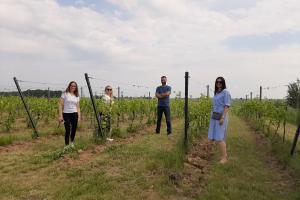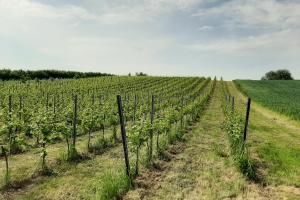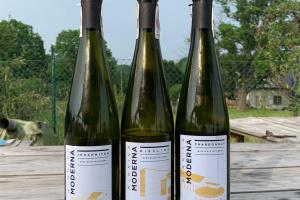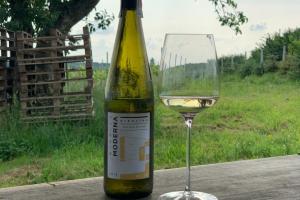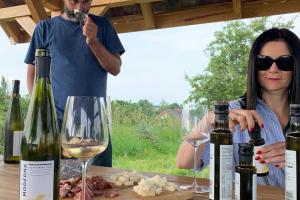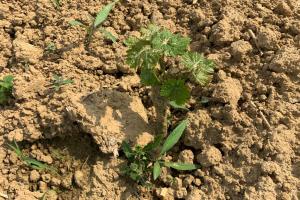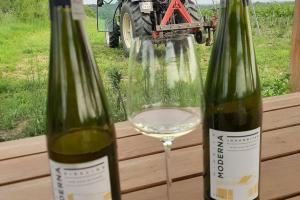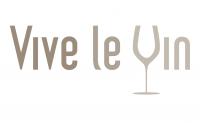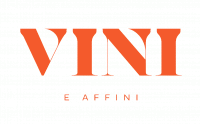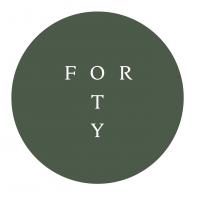Blog
It all started from us drinking wine together … - an interesting and funny interview with Nestor Kościański, winemaker and owner of Winnica Moderna
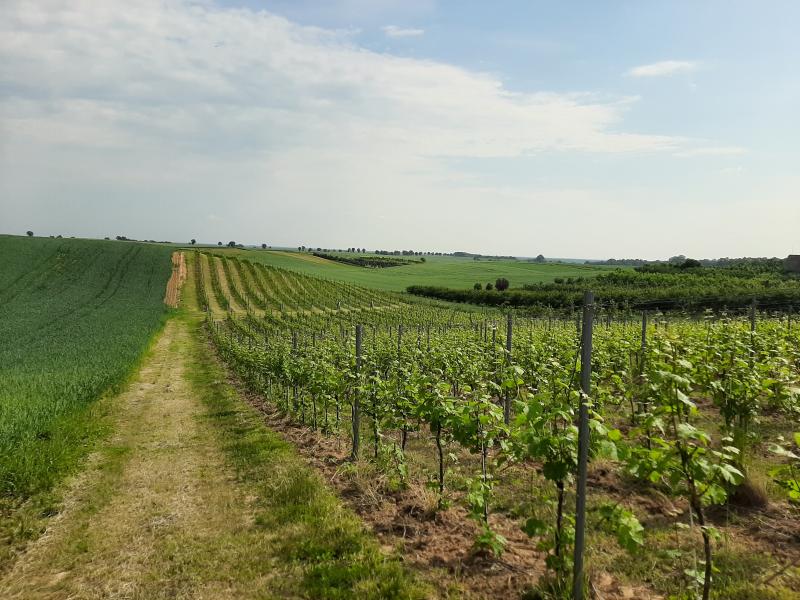
Winnica Moderna. Why the name Moderna? Apparently, the name of the winery came from a passion for modernism – the architectural style - shared by Nestor Kościański and two women, Nestor’s wife and his associate, who both happen to have the same first name: Katarzyna (or Kasia for short). What’s more, all the labels also express this interest in modernism and the buildings we can see on the wine labels were inspired by interesting examples of this architectural style that Nestor and both Kasias observed during their walks through the city of Wrocław.
We met Nestor in his vineyard on a hot afternoon last June. It was our first wine-stop of the day, and the third wine tasting of our weekend wine tour. Winnica Moderna consists of two parts: a larger vineyard, spread over small terraces, around 1 km away from the village of Krakowiany, and the smaller vineyard located in the village itself, next to a lovely house and stables belonging to Winnica Moderna. This is where they organize wine tastings for visitors.
The bigger vineyard is around 1 km away, offering a picturesque view of the surrounding fields and orchards. A total area of almost 2 hectares has already been planted with vines, while there are nearly 3 and a half additional hectares available to expand the vineyard.
- We planted the first vines in 2015, then in 2016 we added three rows of Riesling – explains Nestor as we start our walk through the vineyard.
- So, you made your first wine 3 years later, right? – we wanted to be sure, as usually it takes 3 years for a vine to produce fruits.
- No, we actually made our first wine in 2016 – said Nestor – as the loess soil we have here, which is a silt soil, is rich and fertile. It ensures a good supply of water, good soil aeration, extensive penetration by plant roots, and easy cultivation. We also have a micro-climate here, it’s a warm part of the country with a long vegetation period, so all plants, including vines, grow quickly here. This is also an alkaline soil which is very good for the vines and means we practically don’t need to fertilize. We do use fertiliser made from grounded rocks from time to time, which includes potassium, magnesium and calcium.
-The first harvest was only done on one plot, as the vines on the terraces weren’t ready at that time, so it would have been pointless to harvest them (there wouldn’t have been enough grapes and they would have been too small) – explains Nestor.
- Do you handpick the grapes?
- Yes. We knew from the beginning that we would, because terraces are not easy places for harvesting. Also, there isn’t a special harvesting machine in Poland, so we would have to rent it from winegrowers in the Czech Republic, for example. But we were prepared to harvest the grapes by hand, as it is also a great way of selecting the grapes. Vines with unripe or mouldy fruits are not harvested.
- What grape varieties do you grow here?
- We grow Johanniter, Rondo, Cabernet Cortis, Riesling and Chardonnay. And in the middle of the vineyard there are 3 rows of Muscaris. This is a German hybrid of Solaris and Gelber Muscateller – explains Nestor and to answer to one of our questions, he adds that he is able to recognise the varieties they cultivate by the shape and colour of the leaves.
- We haven’t had the chance to taste the Muscaris yet. Will you open a bottle of Muscaris at the tasting? – I ask as it would be an interesting comparison with other wines.
- Unfortunately, we only make a limited number of bottles of this wine. The 2018 stock is already sold-out, and the 2019 wine is still in the tank.
- Do you make sweet wine from Muscaris?
- No, all our wines are dry except for Johanniter Late Harvest, which has 20 grams of residual sugar. This year, I plan to try other types of wine, including two sweets and one sparkling, made using traditional methods (like champagne – author’s note). In total, I have certificates for 9 different wines this year. Also, a Polish wine competition called Polskie Korki will be held next week, a competition organized every year in Poznan, and I’m sending our sweet Cabernet Cortis from 2018 there, which was made with grapes harvested on 1st December, when the fruits were like raisins and there was still 60g of residual sugar left after fermentation (we haven’t had the chance to taste this wine, as it is not on the market yet – author’s note).
- What types of wine do your customers mainly ask for?
- Less experienced wine drinkers ask for half-sweet or half-dry wines, this still hasn’t changed in Poland. For many people, dry wines are too acidic – admits Nestor – This is why it is so important to persuade potential customers to try our wines. Once they taste them, they can enjoy the wines and it turns out that the sugar isn’t that important – this need for sweetness is partially compensated for by the aromatic character of wine.
- And where did the idea of starting a winery come from?
- Oh, it’s a long story. It all started from us drinking wine together.
There is a lot of laughter – Well, we also drink a lot of wine but none of us has a vineyard yet.
- Well, we started to choose our wines more and more consciously – Nestor continues – and each summer we would organize our holiday as a wine tour, visiting wineries. Then, we started to travel and talk to winemakers, to learn about working in a vineyard. We spent a lot of time in Tuscany, as well as in wineries in Moravia, Germany, Austria, and France.
- Later, we had a vague idea that we wanted to have a vineyard. And as I have a farm near Sycowo and we had planted an orchard there in 2014, with apples that are good for making cider, that was the first step. A year later, we planted some vines here, near Krakowiany.
We reach a plot with very young vines, only a couple of weeks old, of the Scheurebe variety (a hybrid of Riesling and Silvaner), which smells and tastes similar to Riesling, but has more grapefruit notes. These vines have been grafted on two different rootstocks, some of the bushes have been planted 70 cm apart, the others 125 cm apart. It is an experimental plot, part of a project funded by the Wrocław University of Environmental and Life Sciences, which includes 16 wineries from the region, including Winnica Moderna. For Nestor is important to observe how the same grape variety will grow when planted on different rootstocks and with different gaps between the two bushes.
- They will study different factors at different vineyards. At Winnica Moderna they will observe the planting, they are going to build a weather station here to collect data about the climate conditions over a period of three years, and we will also be using a mobile bottling plant.
- What’s that?
- It’s a special vehicle with a bottling plant on it, which is attached to the fermentation or aging tanks, and the wine goes straight into bottles – explains Nestor – The total cost of the whole project is 5 million Polish zloty, funded by the PROW fund* and we will all benefit from this: winemakers, the University and students, as well as the region in general.
As we were slowly heading back to the car we noticed nets hanging from the posts at the start of each row of vines. They use these nets to protect the grapes from starlings. Nestor explains that nets are effective, but it is very tiresome to spread and then fold them, and this is neither environmentally friendly nor an economical solution, as they need to change nets every 2-3 years. This is why they plan to use another repellent/alarm system.
- We go jogging here sometimes – says Nestor, showing us part of the vineyard. This comes as a surprise to us – There is 1 km loop, but it’s really exhausting to run as there are more uphills than flat sections – and he continues – Recently, I spoke to the mayor, a former sportsman, about organizing a race in our vineyard.
- Yes, you could have a Riesling race – jokes one of my friends, making us think of the famous marathon organized in France, where the competitors run between vineyards.
We return to the smaller vineyard where the tasting has already prepared. On the way, we pass a picturesque loess gorge, a small historical palace – a Tuscan style palace, Nestor jokes, and adds - There used to be a palace like this in practically every village in the region, but most of them were destroyed by the Soviets. Luckily, some of them, like this one, or the one in Boleścin, survived. In our village, Krakowiany, the palace was destroyed.
The wine tasting has been arranged at a big table under a wooden roof with a great view of the vineyards and the fields, as well as the house and the stables. Our hosts have prepared some local appetizers for us: cold meat, ham and small sausages called kabanos (very tasty), fresh baguettes from a small bakery in Wrocław called Pan Kłos and a few different oils made in an oil press in Milicz. The hazelnut oil is delicious, but I leave it until after the tasting as I want to keep my palate clean to enjoy the wines.
We start with the fresh and slightly aromatic Johanniter, which is elegant with a nicely balanced acidity and a pleasant finish.
Next up is the Riesling, which surprisingly is more aromatic, with more acidity and less residual sugar.
The last wine is a Chardonnay – pure, fresh and unoaked.
All the wines are from 2018, a very hot year, yet they are all fresh and crispy, elegant with a slightly mineral character.
Nestor explains that in the case of the Chardonnay, they keep the wine on the lees** for almost 5 months, and then they take part of sediment away and keep it longer on a thinner layer of lees. They also use the bâtonnage technique***, during the first month they stir the wine every week, then every other week, and then less regularly.
Each bottle has a lovely label with a modernist building on it: on Johanniter we can see a villa from the WUWA estate; on the Chardonnay there is the terminal of the old airport in Wrocław; and a hydropower plant adorns the Riesling. The style of these labels is similar to the style of posters from the inter-war period. The labels are made by Nestor’s friend, Łukasz Paluch, a graphic designer and artist who works at the Graphic Department at the Wrocław Academy of Fine Arts.
-As we make such a small quantity of Muscaris, every year we design a new label with a different modernist building – says Nestor – We’ve had a label with the Maślice residential area, and one showing the Chemistry Auditorium building.
The vineyard in front of us was planted in 2019 with Pinot Noir and Pinot Gris grapes. As the bushes are still very young, Nestor expects that this first harvest will only yield half a kilo of grapes per bush. In the coming years, the vines should provide 1.5 kilograms on average. According to Nestor’s experience, the vitis vinifera varieties like Pinot Noir, Riesling or Chardonnay, have a lower yield, but hybrid vines are more fruitful, while maintaining the same quality – on average each vine provides almost 3 kg of good grapes.
We have to finish the wine tasting as we are all running out of time – it’s a long weekend, which should be relaxing, but Nestor has another appointment in Wrocław, and we need to head to the next winery for another wine tasting. But we are taking our time, because this is a very pleasant spot to sit, enjoy the view, the warm breeze and the stories of our host. Winegrowing and winemaking is a hard work, no matter the weather conditions, and is also unpredictable, but on an afternoon like this it’s easy to imagine that Nestor and his colleagues live a wonderful live far away from the hustle and bustle of the big city. Although Wrocław is actually only around half an hour away.
*PROW fund – Program Rozwoju Obszarów Wiejskich fund (Development Program for Villages)
**on the lees – to keep the wine on the lees or lees aging describes a stage in the wine maturation process. The lees are the dead yeast cells and other particles which remain in wine after fermentation, and they settle as sediment or creamy mud at the bottom of the fermenting container (a tank, a wooden barrel or even a bottle in the case of Champagne and bottle fermented sparkling wines). Breaking dead lees releases all sorts of compounds which interact with the fermented wine. This interaction creates complexity, aroma and flavour, palate weight and texture in a wine.
*** bâtonnage - while the lees are in contact with the wine they are often stirred to augment the influence of the lees on the wine (this French technique is used mostly in Burgundy).

